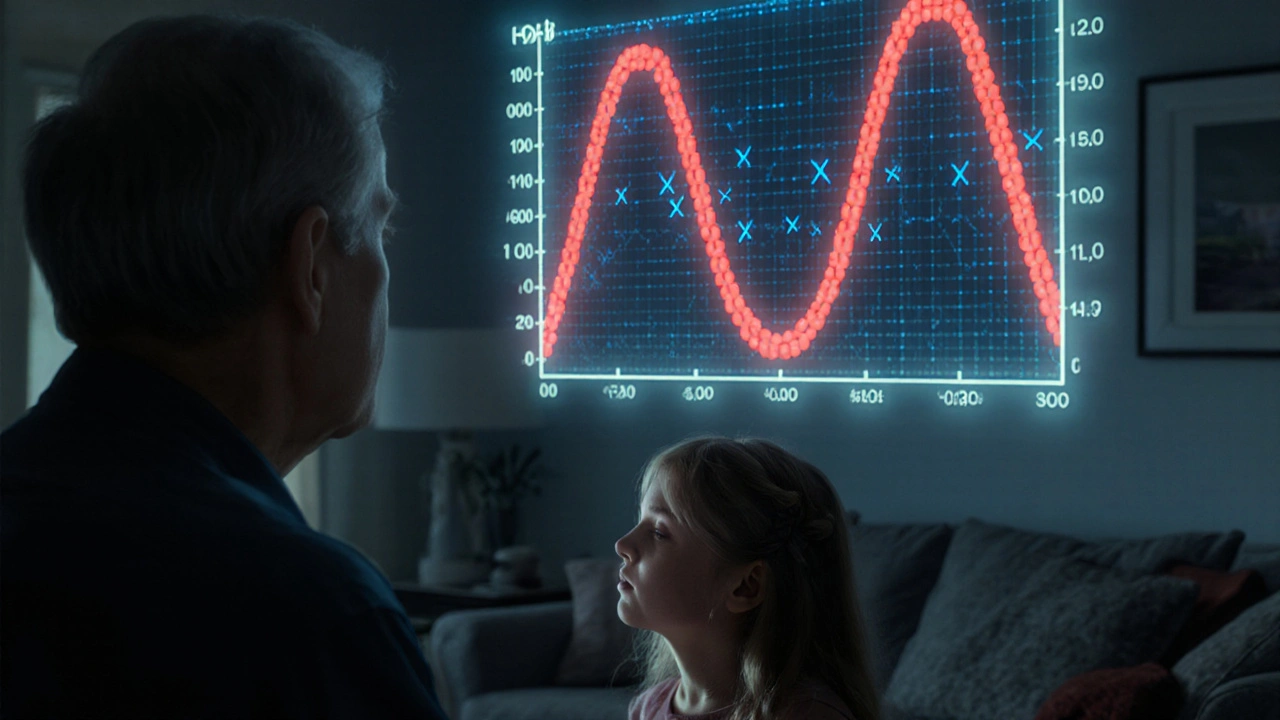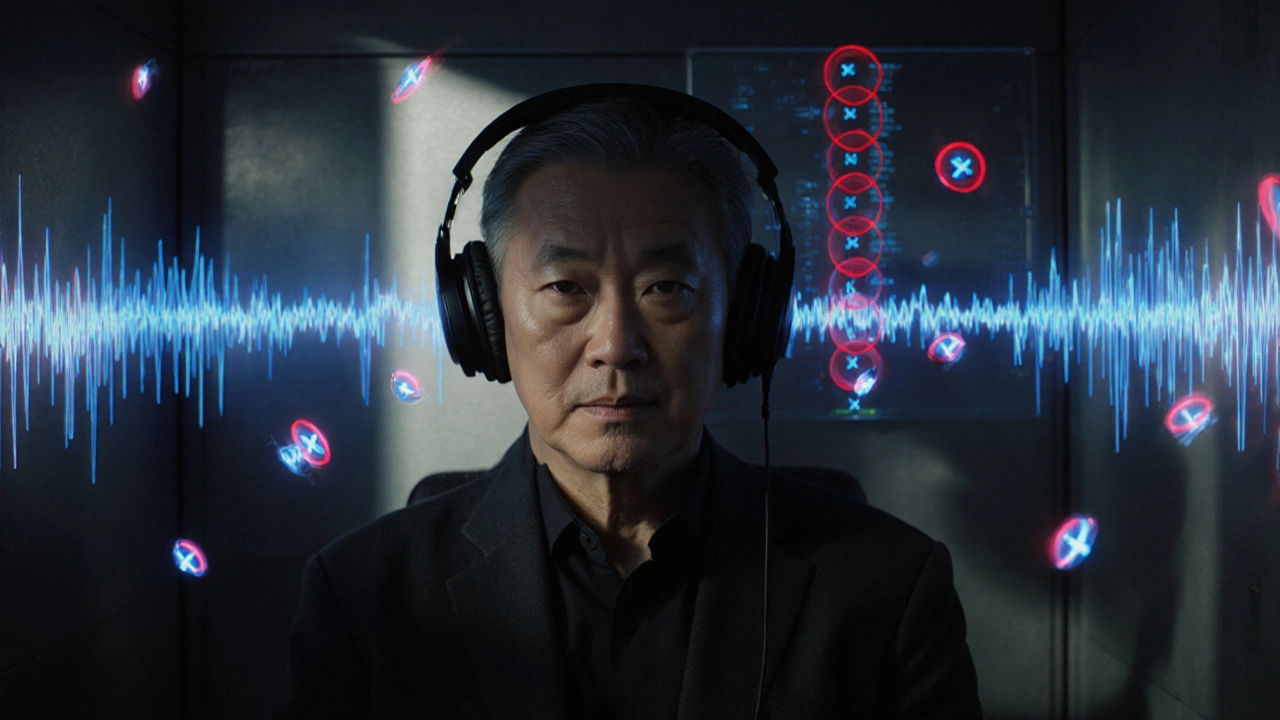When you can’t hear the doorbell, struggle to follow conversations in noisy rooms, or keep asking people to repeat themselves, it’s not just annoying-it might be a sign your hearing is changing. Audiometry testing is the most reliable way to find out exactly what’s going on. It’s not a guess. It’s a science. And it all comes down to one thing: decibel levels.
What Happens During an Audiometry Test?
You sit in a quiet room, wear headphones, and wait for tones to play. That’s it. But behind those simple sounds is a precise system designed to measure the quietest sound your ears can detect at different pitches. This is called pure-tone audiometry, and it’s the gold standard for hearing assessment. The test starts at 1,000 Hz-a middle pitch-and plays a tone at 40 decibels (dB), which is about the sound of a quiet refrigerator. If you hear it, the audiologist lowers the volume by 10 dB. You keep responding until you no longer hear it. Then they go up in 5 dB steps until you hear it again. That’s your threshold-the softest sound you can detect half the time. They repeat this for 250 Hz, 500 Hz, 1,000 Hz, 2,000 Hz, 4,000 Hz, and 8,000 Hz. These frequencies cover the range of human speech. You’ll also get bone conduction testing. A small device taps gently against the bone behind your ear, sending sound straight to the inner ear. This skips the outer and middle ear. If your air conduction thresholds (through headphones) are worse than your bone conduction thresholds by 15 dB or more at multiple frequencies, you have a conductive hearing loss-likely due to wax, fluid, or a problem with your eardrum or ear bones.What Do the Decibel Numbers Really Mean?
Decibels (dB HL) aren’t just numbers on a chart. They tell you how much louder a sound needs to be before you can hear it compared to someone with normal hearing. The scale starts at 0 dB HL, which is the quietest sound a healthy young adult can hear. Anything above that means you need more volume. Here’s what the numbers actually mean in real life:- 0-25 dB HL: Normal hearing. You hear whispers, leaves rustling, and clocks ticking.
- 26-40 dB HL: Mild hearing loss. You miss soft speech, struggle in group chats, and often think people are mumbling.
- 41-55 dB HL: Moderate hearing loss. Conversations become hard without lip-reading. TV volume is too loud for others.
- 56-70 dB HL: Moderately severe. You need hearing aids to follow most conversations. Background noise makes understanding nearly impossible.
- 71-90 dB HL: Severe. You hear loud sounds but miss most speech. Hearing aids are essential.
- 91+ dB HL: Profound. You may only perceive vibrations. Cochlear implants are often considered.
One patient in Hobart, 62, told me he didn’t realize his 45 dB loss at 2,000 Hz meant he was missing consonants like “s,” “t,” and “k.” That’s why people say you “hear but don’t understand.” It’s not your brain-it’s your ears.
Why Speech Testing Matters More Than You Think
Pure-tone tests tell you how loud a sound is. But speech audiometry tells you how well you understand it. Two people might have the same decibel threshold, but one understands 90% of words while the other only gets 40%. That difference changes everything. Speech Reception Threshold (SRT) checks the lowest volume where you can repeat 50% of two-syllable words like “baseball” or “hotdog.” It should match your average pure-tone result within 10 dB. If it doesn’t, something’s off-maybe a tumor on the hearing nerve, or damage from noise or aging. Then there’s speech discrimination testing. You hear a list of simple words at a volume 25-40 dB above your threshold. If you score below 70%, it’s a red flag. You might have sensorineural damage, even if your tones look “normal.” That’s why skipping speech testing is like checking your car’s fuel gauge but never turning the key.Tympanometry and Other Supporting Tests
Audiometry doesn’t stop at tones and words. Tympanometry checks if your eardrum moves properly. A tiny probe seals your ear canal and changes the air pressure. If your eardrum doesn’t respond, it could mean fluid behind it-common in kids after colds or in adults with Eustachian tube problems. The results show up as a graph. A normal shape looks like a mountain. A flat line (Type B) means fluid or a perforation. It takes five seconds. But it tells you more than any tone ever could. For babies, infants, or people who can’t respond reliably, there’s Auditory Brainstem Response (ABR). Electrodes on the scalp record how the hearing nerve responds to clicks. No cooperation needed. It’s how newborns are screened in hospitals. If a baby fails the first test, they’re back for a full ABR by three months. Early detection means better outcomes.
What the Results Look Like: Reading Your Audiogram
Your results are drawn on a chart called an audiogram. The horizontal axis shows frequency-from low (250 Hz) to high (8,000 Hz). The vertical axis shows loudness in dB, from 0 at the top to 100 at the bottom. Symbols matter:- Red circles = Right ear air conduction
- Blue X’s = Left ear air conduction
- Blue brackets [ ] = Right ear bone conduction
- Red < = Left ear bone conduction
If the air conduction points are lower (worse) than bone conduction, you have a conductive loss. If both are equally poor, it’s sensorineural-likely from aging, noise, or genetics.
One common pattern is a “notch” at 4,000 Hz-a dip shaped like a U. That’s classic noise-induced hearing loss. People who work in factories, concerts, or even listen to headphones too loud often show this. It’s not always obvious until you see the audiogram.
Why This Test Is So Important
Hearing loss isn’t just about missing the TV. It’s linked to loneliness, depression, and even dementia. The CDC says untreated hearing loss doubles the risk of cognitive decline. But the good news? Audiometry catches it early. The American Academy of Family Physicians says pure-tone audiometry is the most accurate tool we have. It’s not perfect-but it’s the best. And it’s non-invasive. No needles. No radiation. Just tones, responses, and a chart. For adults over 50, getting tested every two years is smart. For people exposed to loud noise-construction, music, machinery-annual tests are recommended. And if you’ve had sudden hearing loss, you need to be seen within 72 hours. Time matters.Common Misconceptions and Pitfalls
Some people think if they can hear loud sounds, their hearing is fine. Not true. You might hear a dog barking but miss your grandchild saying “I love you.” Others believe hearing aids will fix everything. But if your speech discrimination is below 50%, hearing aids help less. You might need assistive devices, lip-reading training, or even cochlear implants. And masking? That’s when one ear is so much better than the other that the good ear hears the sound meant for the bad ear. Audiologists use noise to block that. Skip masking, and your results are wrong. About 12% of tests have errors because of this.
What Comes After the Test?
If your hearing is normal, great. Keep checking every few years. If you have a mild loss, you might not need hearing aids yet-but you should protect your ears. Turn down the volume. Use earplugs at concerts. Avoid noisy environments when you can. If you have moderate to severe loss, hearing aids are the next step. Modern ones can connect to your phone, reduce background noise, and even adjust automatically. But they only work if the audiogram is accurate. For children, early diagnosis means speech therapy and hearing devices can help them develop language on time. That’s why newborn screening is mandatory in the U.S. and Australia.Who Performs Audiometry?
Only licensed audiologists are trained to do full diagnostic testing. They have doctoral degrees, clinical experience, and certification from organizations like ASHA. General practitioners can screen, but they don’t have the tools or training to interpret complex patterns. In Australia, audiologists work in hospitals, private clinics, schools, and even telehealth setups. With rural areas short on specialists, tele-audiology is growing. But for accurate thresholds below 25 dB, in-person testing is still the standard.Final Thoughts
Hearing loss doesn’t happen overnight. It creeps in. You adapt. You think you’re fine. But your brain is working harder just to keep up. Audiometry doesn’t just measure decibels-it measures your quality of life. If you’ve been struggling to hear, don’t wait. Get tested. The process is simple. The results are clear. And the next step-whether it’s earwax removal, hearing aids, or just awareness-is yours to take.How long does an audiometry test take?
A full diagnostic audiometry test usually takes 20 to 30 minutes per ear. This includes air and bone conduction testing, speech recognition, and tympanometry. Screening tests, like those in schools or workplaces, can be done in 5 to 10 minutes but don’t give a full picture.
Is audiometry painful?
No, it’s not painful. You might feel slight pressure from the earphones or a gentle vibration from the bone oscillator behind your ear. Some people with glasses find the bone conduction test uncomfortable because the device presses against the temple. But there’s no pain, no needles, and no side effects.
Can I do audiometry at home?
You can use apps or online tools for basic screening, but they’re not reliable for diagnosis. Home tests can’t control background noise, calibrate headphones properly, or use masking. Only clinical audiometry with calibrated equipment meets standards for accurate results. The FDA allows some tele-audiology systems, but they’re still limited for low-level hearing loss.
What’s the difference between air conduction and bone conduction?
Air conduction sends sound through your ear canal, eardrum, and middle ear bones to the inner ear. Bone conduction bypasses those parts and sends vibrations directly to the cochlea through the skull. If air conduction is worse than bone conduction, it means something is blocking sound in the outer or middle ear-like wax, fluid, or a damaged eardrum.
What does a 40 dB hearing loss mean?
A 40 dB hearing loss means you need sounds to be 40 decibels louder than the normal threshold to hear them. You’ll miss soft speech, struggle in noisy places, and often think people are mumbling. It’s classified as mild to moderate hearing loss. Hearing aids can help significantly at this level, especially if speech recognition is still good.
How often should I get my hearing tested?
If you’re over 50, get tested every two years. If you’re regularly exposed to loud noise-like at concerts, construction sites, or while using power tools-get tested annually. If you notice sudden changes in hearing, see an audiologist immediately. For children, hearing should be checked before school and if there are concerns about speech development.
Can hearing loss be reversed?
Sensorineural hearing loss, the most common type, is usually permanent. It’s caused by damage to hair cells in the inner ear. These don’t regenerate. But conductive hearing loss-like from earwax, infection, or fluid-can often be treated and reversed. That’s why accurate testing matters: it tells you which type you have and what options are available.

Patrick Marsh
November 24, 2025 AT 19:43Just got my results back-45 dB at 4k. Guess I’ve been hearing my dog bark but not my kid saying ‘I love you.’
Ravi Kumar Gupta
November 26, 2025 AT 08:55Bro, in India, we think hearing loss is just ‘old age’-until your daughter has to yell ‘MAMA!’ three times for you to notice she’s crying. This post? It’s a wake-up call. Audiometry isn’t a luxury-it’s survival.
Nikhil Chaurasia
November 26, 2025 AT 22:13I never realized how much I was missing until I started lip-reading my own wife. She thought I was zoning out. Turns out, I just couldn’t catch the ‘s’ in ‘sunshine.’
Holly Schumacher
November 27, 2025 AT 05:07Let me just say-this article is meticulously researched, grammatically flawless, and clinically accurate. I work in audiology, and I’ve never seen such a clear, comprehensive breakdown of audiometry. The distinction between air and bone conduction? Perfectly explained. The 12% masking error statistic? Shocking but true. You’ve done the field a great service.
Michael Fitzpatrick
November 27, 2025 AT 08:04I’m 58 and had no idea my hearing was slipping. I thought I was just tired. I started ignoring people because I didn’t want to keep saying ‘what?’ But after reading this, I went in for a test. Turned out I had a 40 dB dip at 3k-classic noise damage from years of power tools and concerts. Got hearing aids. Life changed. I hear my granddaughter say ‘butterfly’ now. And it’s not just the sound-it’s the meaning. I didn’t realize how hard my brain was working just to keep up. Seriously, if you’re over 50 and think you’re fine… you’re not. Go get tested. It’s free at most clinics.
Shawn Daughhetee
November 27, 2025 AT 16:19my wife made me go after i kept asking her to repeat herself during movie night. turns out i was missing half the dialogue. i thought it was the subtitles being bad. turns out it was me. got my first hearing aids last week. they’re tiny. no one even noticed. but i heard my dog sigh. that was weirdly emotional
Justin Daniel
November 29, 2025 AT 07:46Fun fact: that ‘notch’ at 4k? That’s the fingerprint of modern life. Headphones. Construction. Airplanes. We’re all slowly going deaf and calling it ‘normal.’
Melvina Zelee
November 30, 2025 AT 17:47so i got my audiogram and it looked like a mountain range… but only on one side. my left ear is basically a ghost. i thought i was just left-handed with my hearing. turns out i’ve been missing half the world. i cried in the waiting room. not because i’m sad… but because i realized i’ve been pretending for years. thanks for writing this. it helped me stop pretending.
ann smith
December 2, 2025 AT 08:07Thank you for this thoughtful, well-researched piece. 🙏 Hearing health is so often overlooked, yet it impacts every relationship, every moment of joy. Early detection truly changes lives. I’ve recommended this to every friend over 50. Keep sharing knowledge like this. 💛
Julie Pulvino
December 3, 2025 AT 14:07My dad had a 75 dB loss and refused hearing aids for years. Said they made him feel ‘old.’ Then one day he heard his dog bark for the first time in 3 years. He called me sobbing. Now he wears them every day. He says he feels ‘present’ again. This isn’t about volume. It’s about connection.
Danny Nicholls
December 4, 2025 AT 04:52just got my results and my audiogram looks like a zig zag. turns out i have a 40 db loss at 4k. i thought i was just bad at listening. turns out i’ve been missing consonants my whole life. got my first hearing aids today. they look like tiny earbuds. i’m already hearing the fridge hum. weirdly comforting. 🤖🎧